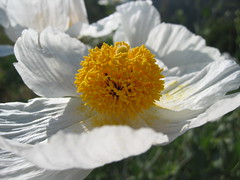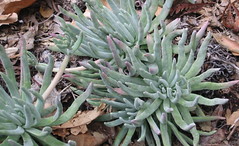It's about darn time that California native plants get their own publicist. I nominated myself and so here I am, writing a blog devoted to everything Cal native. I want to spread the word about these under-rated plants because I'd like to see them in every nursery in Southern California, in every garden, in every median strip along our roads, and in every landscape. OK, OK, that may be a little too ambitious, but it's worth a try.
So, to that end, this blog goes out to all you SoCal gardeners looking to save some water, create habitat in your yard, re-create old California, create ecological balance, stem the tide of invasive plants, and just be responsible gardeners in general.
This blog is a space where gardeners of conscience can gather to swap ideas about using California native plants and gain new ideas.
This blog will also provide many resources for people looking to garden with California natives. In the future, look here to find out about garden tours, plant sales, nursery information, etc.
So, here's my first post:
In response to one of my favorite gardening/design/lifestyle magazines, I am offering my own suggestions for easy, foolproof perennials for lazy gardeners (like myself).
First, I highly recommend
Iris douglasiana. It's striking. It multiplies. You can divide it in a few years and have more plants to spread around the garden. It needs light shade. It can be used safely under oaks (that is, once established,
Iris douglasiana needs little to no water in the summer, a time when our native oaks cannot take watering). I love Douglas Iris. You will too.
One of my new favorite natives is
Nassella lepida, or Foothill Needlegrass. This perennial bunchgrass has a lovely, dainty, flowy look. It gets to about 2X2 feet. It needs sun to part shade and little to no water once established.
You'll see me writing the above phrase a lot: "once established." What I mean by this is that, while many Cal native plants can boast serious drought tolerance, none are immediately drought tolerant once planted. They need some babying in the first year after they're planted. We'll get into that more later.
My third easy perenniall offering is
Salvia 'Allen Chickering'. This beauty gives a one-two-three punch with its gorgeously fragrant leaves, shimmery gray green color, and eye-catching blue flowers (which, by the way are loved by hummingbirds and bees. So really this is a four-punch plant!). Size details: about 4 feet tall and 8 feet wide. Put this puppy near your garden's entrance and let it brush your pants each time you walk into the garden. Yum! 'Allen Chickering likes sun/light shade and is very drought tolerant - when? you guessed it: once established.
Onto number four. I love me some native Coral Bells. I just put Heuchera 'Chocolate Ruffles' (oops, actually not a native - edit: 7/6/05) into a container in our front courtyard and it is going gangbusters. It is currently in bloom. Give it well-draining soil, light shade and it'll get to its estimated foot and a half height and width. The label says it has pink flowers but they seem white to me, and that is fine by me.
Oh, my next new fave is
Verbena lilacina, or Cedros Island Verbena or Lilac Verbena. This GORGEOUS perennial is also in containers in my courtyard, and, so far, it is quite happy getting part sun and part shade. Lilac Verbena looks magnificent in hanging baskets as it cascades over the sides. It has deeply cut leaves and clusters of lilac-colored flowers nearly all year in mild climates. Size: 1 foot hight by 3 foot wide or more.
Last but certainly not least, I'm going to throw you a little bit of a curveball here:
Dudleya hassei. It's a stunning succulent perennial that sends out petite white flowers on branched stems. Oh do I love California native Dudleyas. They are fabulous in pots. They can take almost all day sun (probably half day in hotter areas when they are in pots). They need good drainage.
That should give you something to chew on until the next post. I'll try to put up photos soon!!
Happy native planting!!!


